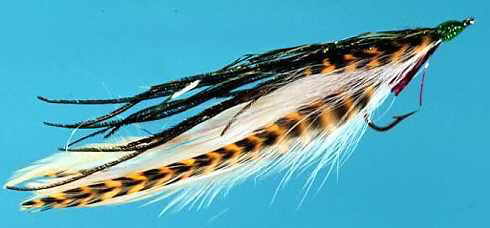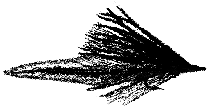
 Several years ago, I caught my first saltwater fish on a fly - a snook... and you guessed it. The fly I used was the most famous of saltwater patterns, Lefty Kreh’s Deceiver. Ironically, later that same summer, I used the same pattern (in the same white collar on white tail color) to catch a 3 pound largemouth in one of Wisconsin’s small spring fed lakes. My experience is not unusual and this venerable pattern has caught fish on both coasts of the U.S. as well as in many salt and freshwater fisheries abroad. There are also reports of using the Deceiver to catch stillwater trout, western river silver salmon and Midwestern northern pike.
Several years ago, I caught my first saltwater fish on a fly - a snook... and you guessed it. The fly I used was the most famous of saltwater patterns, Lefty Kreh’s Deceiver. Ironically, later that same summer, I used the same pattern (in the same white collar on white tail color) to catch a 3 pound largemouth in one of Wisconsin’s small spring fed lakes. My experience is not unusual and this venerable pattern has caught fish on both coasts of the U.S. as well as in many salt and freshwater fisheries abroad. There are also reports of using the Deceiver to catch stillwater trout, western river silver salmon and Midwestern northern pike.
Lefty developed this pattern over 30 years ago for striped bass in Chesapeake Bay and almost any book on fly tying and especially saltwater fly fishing will describe its superior qualities.. There are several reasons the Deceiver pattern is so successful. First, it really is not a single pattern, but a style of fly. It can be tied in just about any color, size or length you can think of. Because of its versatility, by varying the colors and how fully it is dressed, you can use it to represent almost any kind of baitfish. Secondly, while the Deceiver can represent a fairly large baitfish, it has little air resistance and is thus fairly easy to cast. Finally, you can control the degree to which the fly sinks by how heavy you make the collar. The heavier the collar, the less it will sink..
While the standard colors are white tail with white collar, white tail with red collar, or yellow wing with red collar, green and white, all black, green and yellow, or even red and yellow are listed in some pattern books.
MATERIALS
HOOK: Regular or long-shanked streamer hook, size depending upon use. For saltwater use a Mustad 34007, sizes 3/0 - 2
THREAD: Red pre-waxed monocord
TAIL: 1-10 pairs of white saddle hackle extending 2-3 inches past bend & several strands of mylar (1/8 inch) ² as long on each side
BODY: Flat silver mylar or tinsel
HACKLE OR COLLAR: White bucktail or calf tail long enough to extend beyond the bend of the hook
TOPPING: Peacock herl or crystal flash
TYING INSTRUCTIONS
Step 1. Tie in tail feathers slightly in front of hook bend. Feathers are tied curved side in generally. There are occasions when they should be splayed. Use 1-10 pairs of feathers are depending on thefullness desired. Next place 6-10 strands of either flash-a-bou or crystal flash along each side of the tail, approximately 3/4 the length of the tail. Generally silver, gold or pearl is used. Put a drop of superglue on the hook shank before tying in tail feathers.
Step 2. Wind thread forward to about to about ¹ inches behind hook eye. If body wrap is desired (tinsel), tie in at this point, wind- tinsel to rear and then forward to tie in point. By wrapping tinsel this way you insure that shank is fully covered.
Step 3. Tie in collar. This should be done in two steps. One half of the collar (usually bucktail) is tied on one side of hook shank and other half is tied on the opposite side. Option 1: Tie in 6-10 strands crystal flash (pearl or rainbow are good) on the underside of shank before tying on collar. These strands should extend to slightly in front of the hook point. Option 2: Tie in 10-15 strands red flash-a-bou or crystal flash on underside of hook shank outside of collar. The red represents gills.
Step 4. For topping add a different color bucktail and 6-12 pieces of peacock herl may be placed on top of this. Optional: 6-10 strands crystal flash tied in on top of topping in same color as topping.
Step 5. Finish head, paint on eyes and give several coats head cement. It is generally thought that by adding gills and eyes to flies that this draws more strikes.
Courtesy of the Federation of Fly Fishers
Uploaded: 2/21/2004

